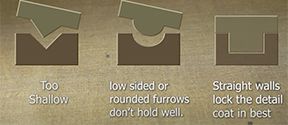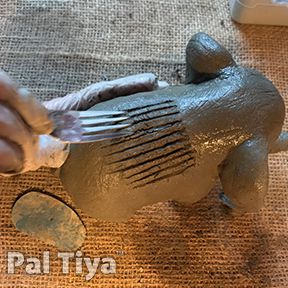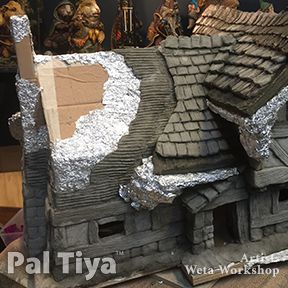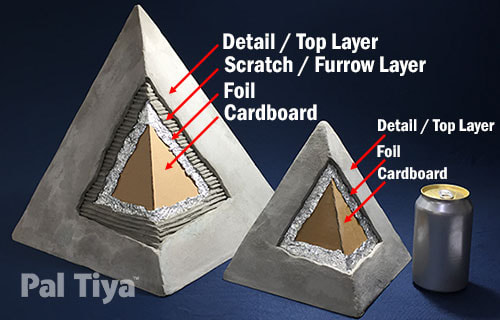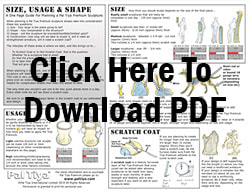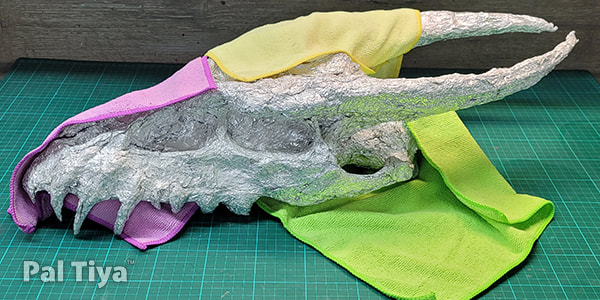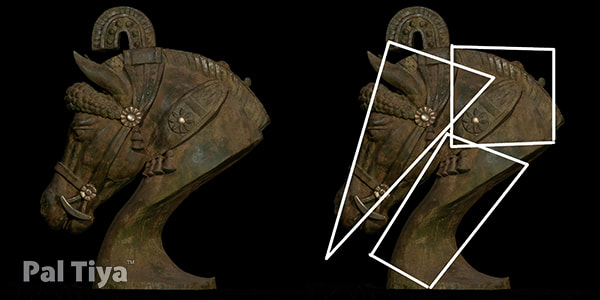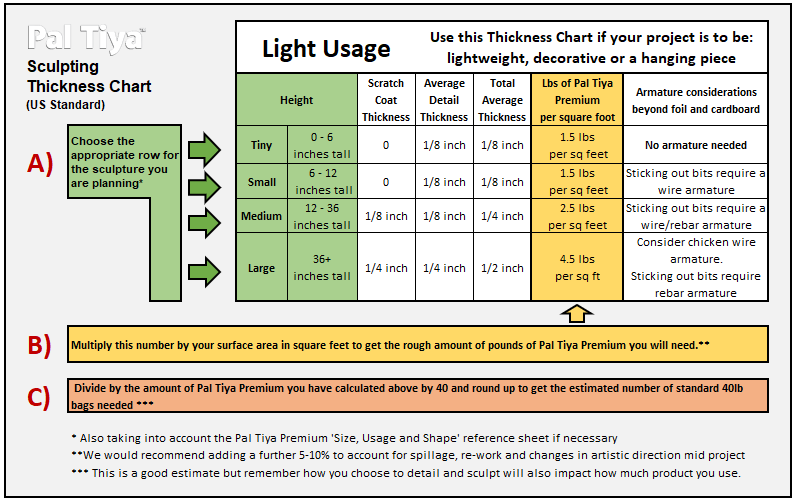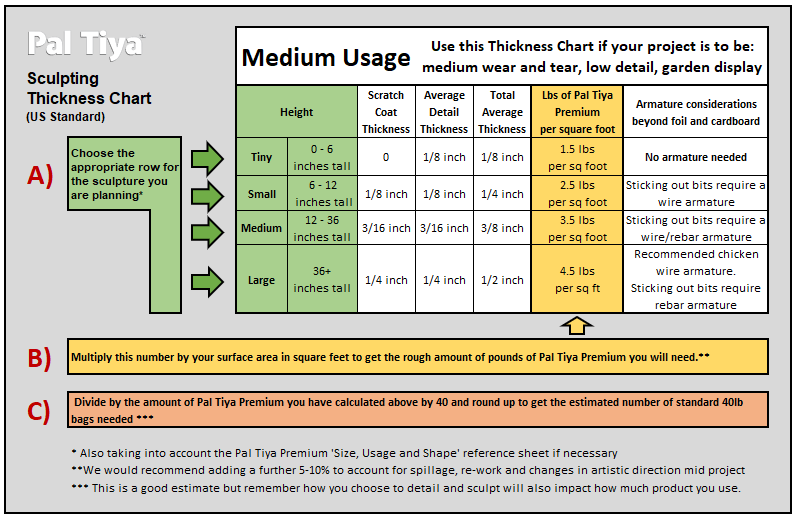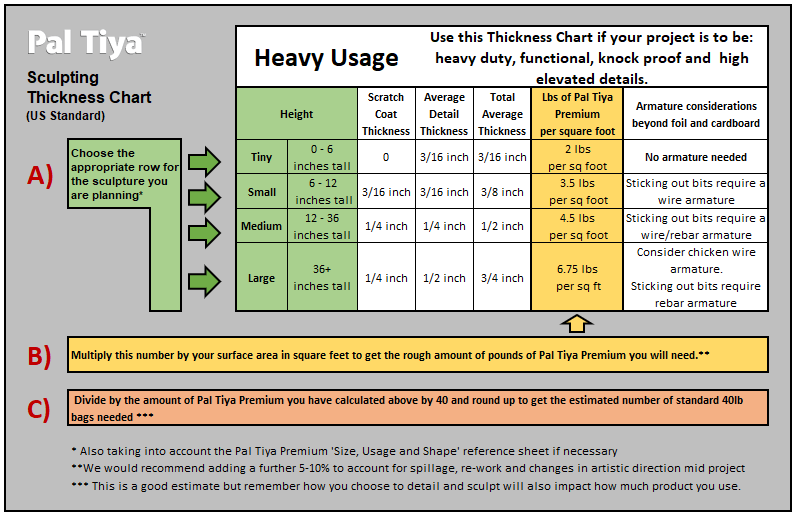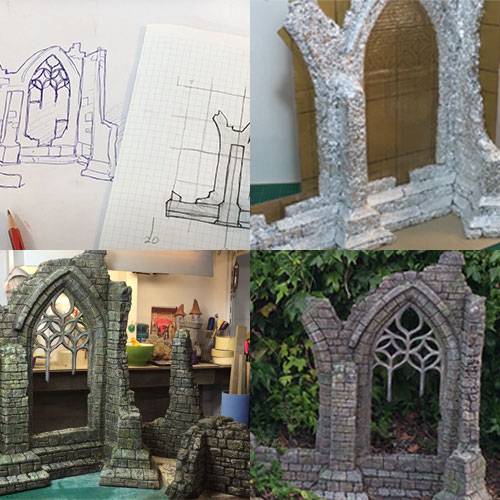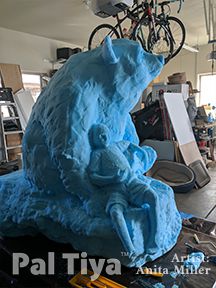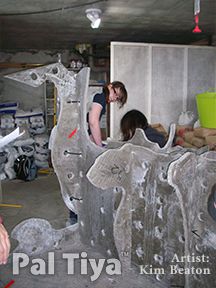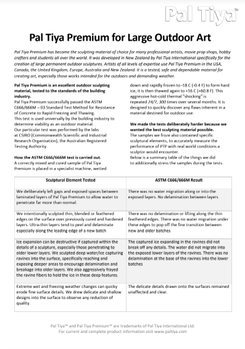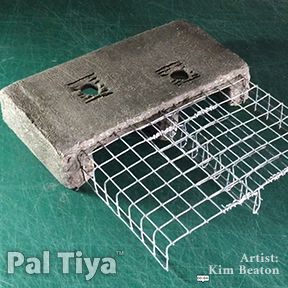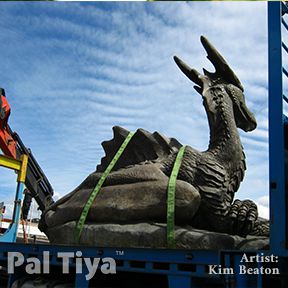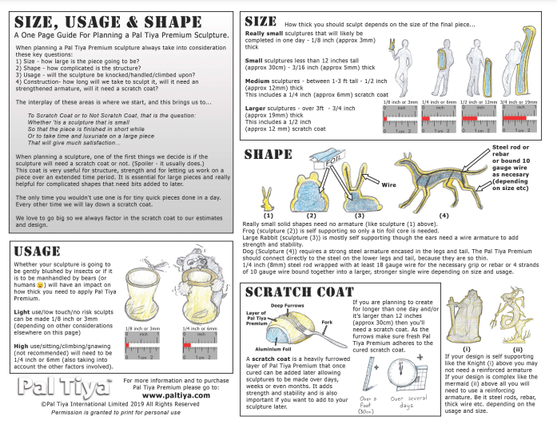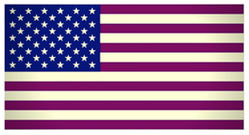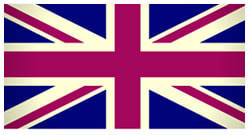Perfect Planning
Make sure you read the 'Before you Start' section on the 'Get Started' page Here
If you are using a simple compact tinfoil armature then you can skip ahead to the armatures page to get going.
If this is your first time using Pal Tiya Premium, this page is designed to inspire and perfect your planning phase.
Discover all the tricky considerations to keep in mind...
If this is your first time using Pal Tiya Premium, this page is designed to inspire and perfect your planning phase.
Discover all the tricky considerations to keep in mind...
When considering your Pal Tiya Premium sculpture always take into account these key questions:
1) Size – how large is my piece going to be?
2) Shape – how complicated is the structure?
3) Usage – will the sculpture be knocked/handled/climbed upon?
4) Construction- how long will I take to sculpt it, will it need a strengthened armature, will it need a scratch coat? How will it be transported?
1) Size – how large is my piece going to be?
2) Shape – how complicated is the structure?
3) Usage – will the sculpture be knocked/handled/climbed upon?
4) Construction- how long will I take to sculpt it, will it need a strengthened armature, will it need a scratch coat? How will it be transported?
One of the first things to decide is if your sculpture will need a scratch/furrow coat or not. (Spoiler – it usually does.)
This coat is a thin, heavily keyed under-layer that strengthens, unifies and binds all subsequent applications. It makes the sculpture monolithic, so is very useful for structure, strength and for letting us work on a piece over an extended time period, especially with bits added much later. It is essential for large pieces.
The only time you wouldn't use one is for tiny quick pieces done in one day.
We love to go big so we always factor in this layer to our estimates and design.
This coat is a thin, heavily keyed under-layer that strengthens, unifies and binds all subsequent applications. It makes the sculpture monolithic, so is very useful for structure, strength and for letting us work on a piece over an extended time period, especially with bits added much later. It is essential for large pieces.
The only time you wouldn't use one is for tiny quick pieces done in one day.
We love to go big so we always factor in this layer to our estimates and design.
If you are planning to create for longer than one day and/or it’s larger than 12 inches (approx 30cm) then you’ll need a scratch coat. As the furrows make sure fresh Pal Tiya Premium adheres to the cured scratch coat at a later date.
Estimating How Much Pal Tiya Premium You Will Need
|
Pal Tiya Premium only requires a relatively thin coat of product (even for larger pieces) You just need to discover the surface area of your sculpture and determine the thickness it needs to be. These measurements help calculate how much you will be using.
Here is the three-step process
|
1. Size Usage and Shape Design Considerations
2. Surface Area Estimation
Method One for Calculating Surface Area (Our go-to approach)
|
Method Two for Calculating Surface Area (Less Making - More Math)
|
If you are unable or unwilling to build a mock up or to finish a foil armature, you can work out the surface area of the final sculpture by roughly breaking the sculpture design into basic geometric shapes, and using third party (not affiliated with us) online apps or a calculator like:
https://www.calculator.net/surface-area-calculator.html or https://apps.apple.com/us/app/area-perimeter-volume-and-surface-calculator/id1226352729 Once you have the rough surface area you can add 10% or so for errors, spillage and changes, and move to step three. |
3. The ‘Thickness Charts’
Choose the relevant category of use: Light/decorative, Medium garden display, or Heavy duty
A) Based on the size of your planned sculpture select the appropriate column.
B) Take your surface area in square feet and multiply it by the corresponding lbs of Pal Tiya Premium - per square foot amount. If desired add 5-10% to this number to cover spillage, changes or work. This will give you the approximate amount of product you will need in lbs
C) Divide this number by 40 and round up – this will be the estimated number of Standard 40lb bags you will use on this piece.
A) Based on the size of your planned sculpture select the appropriate column.
B) Take your surface area in square feet and multiply it by the corresponding lbs of Pal Tiya Premium - per square foot amount. If desired add 5-10% to this number to cover spillage, changes or work. This will give you the approximate amount of product you will need in lbs
C) Divide this number by 40 and round up – this will be the estimated number of Standard 40lb bags you will use on this piece.
How we planned a sculpture of a ruined Gothic Archway.
|
How we planned a sculpture of a ruined Gothic Archway.
Step 1 – First, reading the Size Usage and Shape Reference sheet determined if we need to add stronger armatures or to sculpt thicker. Step 2 – Using those recommendations, we built an actual size mock-up of our idea, and then measured the surface area with cloths/towels. Our design was 27.5 inches in height and had a surface area of approximately 8.5 square feet. Step 3 - With this information we selected the correct ‘Thickness Chart’: Light, Medium, or Heavy A) The Heavy Chart was chosen (because the height is between 12 & 36 inches and it may be climbed on) so we knew it should be sculpted to a total of 1/2 inch thick (1/4-inch scratch coat and 1/4-inch detail coat). B) The Chart told us this thickness is equal to 4.5 lbs of Pal Tiya Premium per square foot We multiplied our 8.5 square feet surface area by the 4.5 lb per square feet sculpting thickness to find that we needed approx. 38.25 lbs of dry Pal Tiya Premium. C) Finally, the weight of 38.25 lbs was divided by 40 to find the estimated 0.96 bags of Pal Tiya Premium. We ordered one Standard 40lb bag for this project. This left approximately 4% or 1.75 lbs of product for spillage, re-work and minor changes in artistic direction mid project. If you want to see ruined archway sculpture created step-by-step click here: Full Ruined Gothic Archway Project |
|
A note on BIG pieces designed for climbing/sitting on:
Pal Tiya Premium is an excellent sculpting material for large scale pieces and can easily be combined with internal armatures to create amazing pieces. PTP is primarily used as a hollow shell material. On larger sculptures, an internal supporting structure is needed. This can be either steel or internal cross sections built of PTP. |
PTP cross sections: These need to be 3/4 inch thick and be positioned to transfer any additional weight applied to the shell to the ground. Often a series of interlocked internal cross sections. Mostly for simple, ground based and non-suspended pieces.
With our Grandpa Dragon for Wellington Zoo, we knew upwards of 2-400 people a day would climb on him, so he was built with these cross sections of PTP. |
|
Durability of Pal Tiya Premium for large outdoor Public Sculptures We have been using Pal Tiya Premium for public sculptures for many years now.
Click on the document pictured or here to understand all about working with our medium for your next public art commission. |
Transportation
You may need a forklift to carry a very large sculpture. If you have used foam as your armature the underside may be crushed by the tines. This will cause the sculpture to tip and make transporting it troublesome and possibly dire - The last thing anyone wants is crushed dragon toes...
There are several ways to prevent this:
1) Carve two channels across the underside for the tines to slide into, and coat with Pal Tiya Premium. This makes the base into essentially a permanent pallet. It also allows for lifting straps to be placed underneath.
2) Add more PTP around the bottom edge till solid 2 inches thick minimum and 4 inches high. This makes a stiff and extra resistant rim so, if lifted by straps, it doesn't crush the thin shell.
3) Do both. This is how we've constructed all of our large pieces and makes them as strong as possible, easy to carry and simplifies the installation by providing an in-built foundation. This is a great selling point for a sculpture. In-built foundations save a lot of installation costs for the client.
4) On very large surfaces to be climbed on, reinforce any suspicious areas with a thickened channel cut deeper into the foam. This will become an internal supporting rib once filled with Pal Tiya Premium.
You may need a forklift to carry a very large sculpture. If you have used foam as your armature the underside may be crushed by the tines. This will cause the sculpture to tip and make transporting it troublesome and possibly dire - The last thing anyone wants is crushed dragon toes...
There are several ways to prevent this:
1) Carve two channels across the underside for the tines to slide into, and coat with Pal Tiya Premium. This makes the base into essentially a permanent pallet. It also allows for lifting straps to be placed underneath.
2) Add more PTP around the bottom edge till solid 2 inches thick minimum and 4 inches high. This makes a stiff and extra resistant rim so, if lifted by straps, it doesn't crush the thin shell.
3) Do both. This is how we've constructed all of our large pieces and makes them as strong as possible, easy to carry and simplifies the installation by providing an in-built foundation. This is a great selling point for a sculpture. In-built foundations save a lot of installation costs for the client.
4) On very large surfaces to be climbed on, reinforce any suspicious areas with a thickened channel cut deeper into the foam. This will become an internal supporting rib once filled with Pal Tiya Premium.
|
Pal Tiya Premium is most effective as a strong hollow shell. This saves both time, effort, materials and money. Build a supporting core first (Foil, foam, wire, etc). Over this, apply your coat of Pal Tiya Premium and begin sculpting.
The total thickness of a Pal Tiya Premium sculpture is dependent on its size. To download our SIZE, USAGE & SHAPE PDF. Click here or the picture to download it. |

